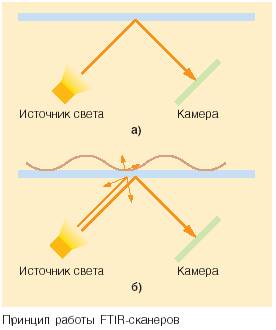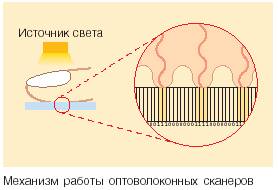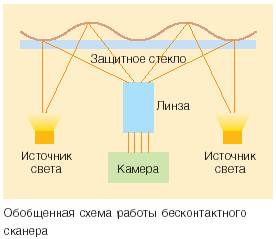Fingerprint scanners. Classification and methods of implementation

About a year ago, while writing a term paper, I had to deal closely with fingerprint scanners. I clearly remember how I was unpleasantly surprised by their diversity - still, because for everyone I had to look for channels of information leakage and write a methodology for their assessment. Nevertheless, the fact remains that at present there are fundamentally different ways of obtaining fingerprints with varying degrees of reliability and efficiency.
About scanning
A little more than a year ago , the issue of biometric identification was raised on Habré, so I’ll give a brief summary of the general information. Physiologically, a fingerprint is a so-called papillary pattern — a configuration of protrusions (crests) containing individual pores separated by depressions. Under the skin of the finger is a network of blood vessels. Also, a fingerprint is associated with certain electrical and thermal characteristics of the skin. This means that light, heat, or capacitance (and their combination) can be used to obtain a fingerprint image. A fingerprint is formed during the development of the fetus and does not change throughout the person’s life, moreover, if damaged after some time, it restores its original structure. Even identical twins do not have identical fingerprints. In terms of reliability, fingerprint scanning is second only to DNA analysis, as well as scanning the iris or retina.
')
All existing fingerprint scanners can be divided into three groups: optical, semiconductor and ultrasound. In addition, in each method there are several ways to implement.
Optical scanners
Optical scanners - based on the use of optical imaging methods. There are several basic ways to implement the optical method:
Optical reflection method
This method uses the effect of broken total reflection (Frusted Total Internal Reflection). The effect is that when light is incident on the interface between two media, the light energy is divided into two parts - one is reflected from the border, the other penetrates through the border into the second medium. The proportion of reflected energy depends on the angle of incidence of the light flux. Starting with a certain value of a given angle, all the light energy is reflected from the interface.

This phenomenon is called total internal reflection. In the case of contact of a more dense optical medium (finger surface) with a less dense at the point of total internal reflection, a beam of light passes through this boundary. Thus, only beams of light that hit certain points of total internal reflection, to which the finger papillary pattern was not attached, will be reflected from the border. To capture the resulting light image of the surface of the finger, a special image sensor is used (CMOS or CCD, depending on the scanner implementation).
Disadvantages of the method:
• Ineffective dummy protection
• Sensitivity to pollution
The leading manufacturers of such scanners are BioLink, Digital Persona, Identix.
Optical method for lumen
Scanners of this type are a fiber-optic matrix in which all the waveguides at the output are connected to photo sensors.

The sensitivity of each sensor allows you to capture the residual light passing through the finger, at the point of contact of the finger with the surface of the matrix. The image of the entire print is formed according to the data read from each photo sensor.
This method has many more advantages:
• High reading reliability
• Resistance to deception
However, this method also has a significant drawback - the complexity of its implementation:
This type of scanner is manufactured by Security First Corp.
Optical proximity scanners
In Optical non-contact scanners (touchless scanners), you will not believe it; no direct contact of the finger with the surface of the scanning device is required. The finger is applied to the hole in the scanner, several light sources illuminate it from the bottom from different sides, in the center of the scanner is a lens through which the collected information is projected onto a CMOS camera that converts the data into a fingerprint image.

The leading manufacturer of scanners of this type is Touchless Sensor Technology.
(For some reason there is nothing about merits / demerits)
Semiconductor scanners
The basis of semiconductor scanners is the use of properties of semiconductors that change at the points of contact of the crests of the papillary pattern with the surface of the scanner to obtain an image of the surface of a finger.
Capacitive Scanners
Capacitive scanners (Capacitive Scanners) are today the most common semiconductor devices for fingerprint imaging. Their work is based on the effect of a change in the capacitance of the pn junction of a semiconductor when the comb of a papillary pattern touches the element of a semiconductor matrix. There are modifications of capacitive scanners, in which each semiconductor element in the matrix acts as one capacitor plate, and a finger as another. When a finger is applied to the sensor, a capacitance is formed between each sensitive element and the protrusion-depression of the papillary pattern, the magnitude of which is determined by the distance between the relief surface of the finger and the element. The matrix of these containers is converted into a fingerprint image.
Advantages due to its popularity are:
• Low cost
• Reliability
Disadvantages:
• Ineffective dummy protection
The leading manufacturers of scanners of this type are Infineon, STMicroelectronics, Veridicom.
Radio frequency scanners
In the radio frequency scanners (RF-Field Scanners) a matrix of elements is used, each of which operates as a miniature antenna. The radio frequency module generates a low intensity signal and directs it to the scanned surface of the finger. Each of the sensitive elements of the matrix receives a signal reflected from the papillary pattern. The magnitude of the emf induced in each miniature antenna depends on the presence or absence of a crest of a papillary pattern near it. The resulting stress matrix is converted into a digital fingerprint image.
Advantages:
• Since the physiological properties of the skin are analyzed, the probability of cheating this scanner tends to zero.
Disadvantages:
• Intermittent operation with poor finger contact.
A well-known manufacturer of radio frequency scanners is Authentec.
Pressure scanners
Pressure-sensitive scanners (Pressure Scanners) in their design use a matrix of piezoelectric elements that are sensitive to pressure. When a finger is applied to the scanning surface, the comb-like protrusions of the papillary pattern put pressure on a subset of the elements of the matrix. The depressions of the skin pattern do not exert any pressure. Thus, the totality of the voltages obtained from the piezoelectric elements is converted into an image of a fingerprint.
This method has several disadvantages:
• low sensitivity
• ineffective dummy protection
• susceptibility to damage due to excessive efforts
Pressure sensitive scanners are released by BMF.
Thermoscanners
Thermal scanners (Thermal Scanners) - in such devices sensors are used, which consist of pyroelectric elements, which allow to fix the temperature difference and convert it into voltage.
When a finger is applied to the scanner, a temperature map of the finger surface is constructed based on the temperature of the protrusions of the papillary pattern touching the pyroelectric elements and the temperature of the air in the cavities, which is subsequently converted into a digital image.
The temperature method has many advantages:
• high electrostatic discharge resistance
• steady work in the wide temperature range
• effective protection against dummies.
The disadvantages of this method include the fact that the image quickly disappears. When you put your finger on the first moment, the temperature difference is significant and the signal level, respectively, is high. After a short time (less than one tenth of a second), the image disappears as the finger and the sensor come to temperature equilibrium.
Ultrasound method
In this group, so far there is only one method, which is called. Ultrasonic scanners (Ultrasonic Scanners) scan the surface of the finger with ultrasonic waves. The distances between the wave source and the ridge protrusions and depressions of the papillary pattern are measured by the echo reflected from them.

The image quality is ten times better than that of any other method presented on the biometric market. In addition, this method is almost completely protected from dummies, because it allows, in addition to the fingerprint papillary pattern, to obtain information about some other characteristics, such as the pulse.
Disadvantages:
• High cost
The leading manufacturer of this type of scanner is Ultra-Scan Corporation.
Literature (as it was in the course):
1. Russian biometric portal (unfortunately, no longer works)
2. Atmel and Fujitsu fingerprint sensors
3. Zadorozhny B. Fingerprint Identification
4. Some Vordovskiy document on my computer called: "Oh, and this is already cool." Unfortunately, I do not remember what it was for the book / site, and why he didn’t make me so happy either)
Source: https://habr.com/ru/post/116458/
All Articles